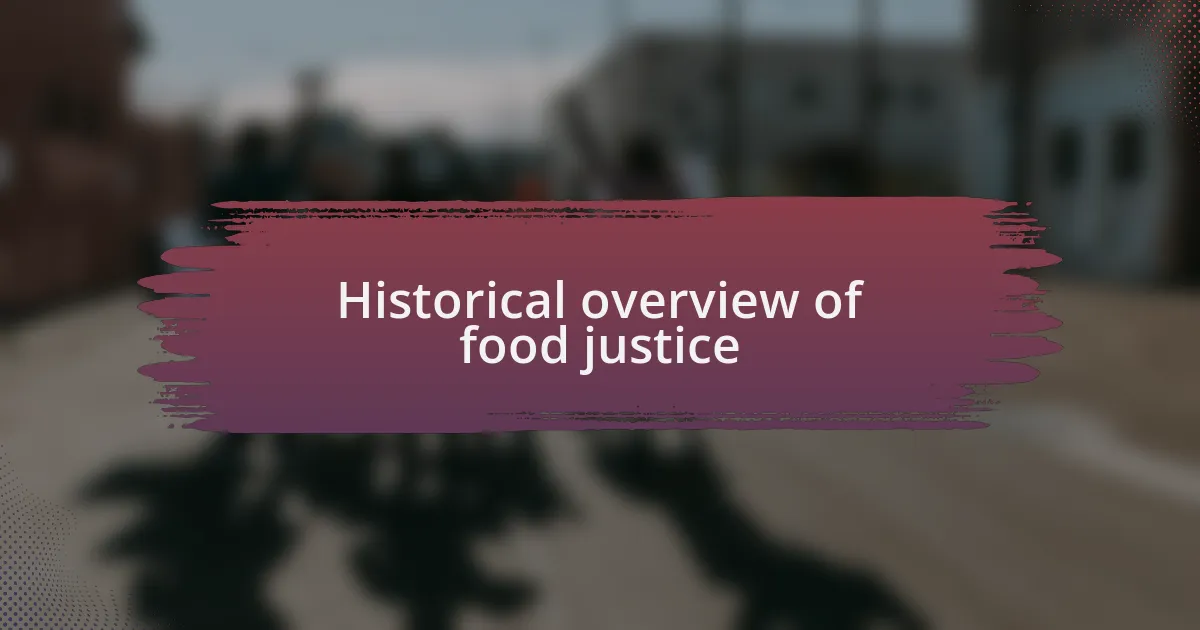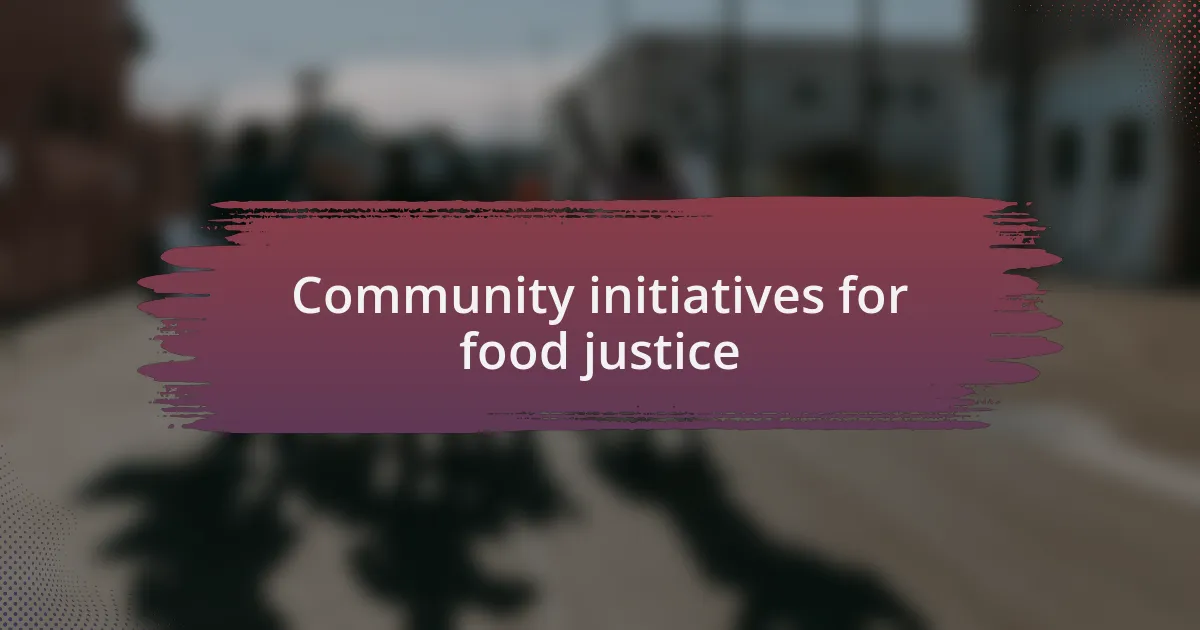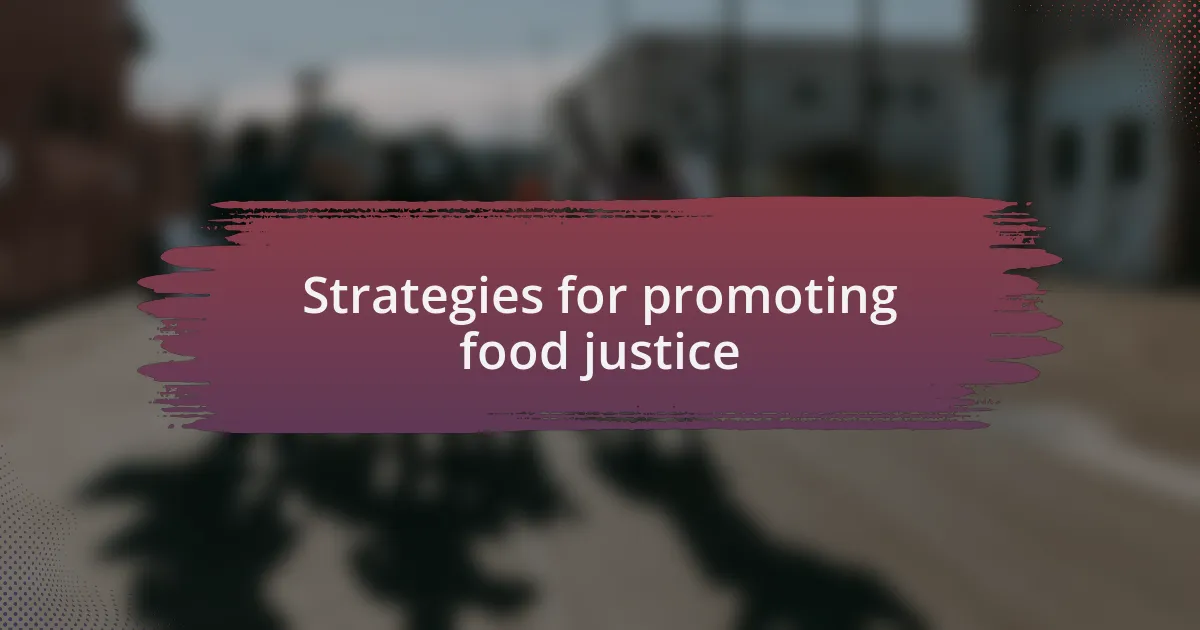Key takeaways:
- Local food justice emphasizes equitable access to nutritious food, highlighting the systemic inequalities that affect food systems and community health.
- Food justice movements empower communities to reclaim control over food production and distribution, fostering resilience and amplifying marginalized voices.
- Historical roots of food justice are intertwined with broader social movements, demonstrating the link between access to food and social equity.
- Community initiatives, such as cooperatives and educational workshops, play a vital role in promoting food justice by fostering collaboration and self-reliance among residents.

Understanding local food justice
Local food justice is fundamentally about ensuring that everyone has access to sufficient, nutritious food, regardless of their socioeconomic status. I remember my first experience working at a community garden. As I dug my hands into the earth, I felt a profound connection to the people around me. It was clear that food isn’t just about sustenance; it’s about community, identity, and dignity.
This concept goes beyond just access to fresh fruits and vegetables. It involves examining the systemic inequalities that shape our food systems. For instance, when I attended a local food justice meeting, I found myself moved by stories of families facing food deserts—areas with limited access to affordable and nutritious food. It was a stark reminder of how geography can dictate one’s health and wellbeing.
Understanding local food justice means recognizing the intersection of food production and social equity. Have you ever thought about how much influence your food choices have on your community? I began to see this connection clearly after volunteering at food distribution events; the expressions of gratitude from fellow community members highlighted how vital access to good food truly is.

Importance of food justice movements
Food justice movements play a critical role in challenging the systemic barriers that prevent equitable access to nutritious food. I recall a community event where we brought together local farmers and residents to discuss how to enhance food access. The energy in the room was palpable, as people shared their thoughts on how local policies could be reshaped to support community-based solutions. It reminded me that collective action can transform food systems for the better.
These movements empower individuals by fostering a sense of agency and community ownership over food production and distribution. When I participated in a workshop on urban agriculture, we discussed how growing our own food can be a revolutionary act. It dawned on me then how reclaiming land for food production not only nourishes bodies but also nourishes resilience, helping communities push back against oppressive systems.
Moreover, food justice movements create spaces for marginalized voices to be heard in the conversation about food systems. I’ll never forget attending a panel where activists shared their personal stories—each one illustrating the fight for dignity and access. It struck me how vital these narratives are; they serve not just as testimonials but as rallying cries that inspire change. Isn’t it fascinating how storytelling can connect us and amplify the urgency of our cause?

Historical overview of food justice
Food justice has deep roots in various social movements, emerging prominently in the late 20th century amid growing awareness of inequities in food access. I remember exploring the early work of organizations like the Black Panther Party, who initiated free breakfast programs for children in underserved communities. Their approach underscored a fundamental truth: that access to nutritious food is a right, not a privilege.
As I delved deeper into food justice history, I was struck by the connections between environmental activism and food accessibility. The environmental justice movement highlighted how marginalized communities often bear the brunt of industrial pollution, influencing their access to clean and healthy food. Reflecting on my participation in local meetings discussing these issues, I saw firsthand how intertwined social, economic, and environmental factors are when advocating for food equity.
Looking back, it’s clear that food justice cannot be understood in isolation; it evolves alongside broader movements for social equity. I often think about the activists who tirelessly documented the experiences of food deserts across the United States. Their commitment to data-driven advocacy not only illuminated hidden disparities but also inspired communities to take action. Isn’t it empowering to know that through the lens of history, we can see both the struggles and the triumphs that continue to shape our present food systems?

Community initiatives for food justice
Community initiatives focusing on food justice are often catalysts for change, bringing people together to advocate for equitable food systems. I remember volunteering at a local community garden where residents not only cultivated fresh produce but also shared knowledge about sustainable practices. There’s something deeply satisfying about seeing neighbors collaborate, transforming not just the land but the community spirit itself.
In one neighborhood, I witnessed the profound impact of a food cooperative that emerged from grassroots efforts. This co-op didn’t just provide affordable groceries; it became a safe space for discussions around racial equity in food access. Reflecting on those conversations, I felt the weight of the community’s collective experiences, as members shared stories of struggle and resilience. How often do we overlook the power of sharing our narratives in reshaping the systems around us?
The role of education in these initiatives cannot be overstated. I participated in workshops where participants learned to prepare healthy, budget-friendly meals. Watching families discover new recipes together sparked excitement and creativity. It made me realize that empowerment often starts with simple acts—like teaching someone how to grow their own food or make nutritious meals. Isn’t it amazing how such initiatives can lead to ripple effects of change, not just in access to food, but in building self-reliance and community solidarity?

Strategies for promoting food justice
One effective strategy for promoting food justice is fostering partnerships between local farms and urban communities. I recall my experience at a city-sponsored event where local farmers shared their harvest directly with residents. The vibrant exchange of goods not only enhanced access to fresh produce but also sparked dialogues about the importance of supporting local economies. How often do we get the chance to connect with those who grow our food? These kinds of interactions can bridge gaps and cultivate mutual respect.
Another approach I’ve found impactful is the incorporation of culturally relevant food into public school menus. During a community forum, I advocated for a program that celebrates the diverse culinary heritage of our students. This initiative not only promotes healthier eating habits but also allows children to see their own cultures reflected in their meals. Isn’t it empowering for kids to know that their food traditions matter? Such strategies reinforce the idea that access to culturally relevant food is also a critical aspect of justice.
Overall, leveraging technology to create mobile apps that identify food resources can play a significant role in advocating for food justice. I remember working with a team that developed a user-friendly platform connecting residents with local food banks and farms. The excitement was palpable when users expressed how they felt more empowered to seek out fresh food options. Could technology be our ally in dismantling food deserts? It’s clear that thoughtful integration of technology can provide essential resources and support those in need.